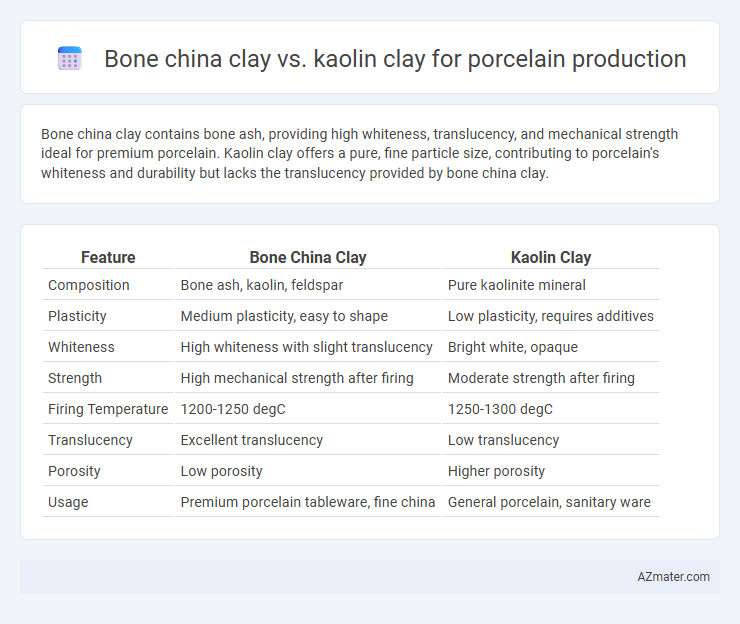Bone china clay contains bone ash, providing high whiteness, translucency, and mechanical strength ideal for premium porcelain. Kaolin clay offers a pure, fine particle size, contributing to porcelain's whiteness and durability but lacks the translucency provided by bone china clay.
Table of Comparison
| Feature | Bone China Clay | Kaolin Clay |
|---|---|---|
| Composition | Bone ash, kaolin, feldspar | Pure kaolinite mineral |
| Plasticity | Medium plasticity, easy to shape | Low plasticity, requires additives |
| Whiteness | High whiteness with slight translucency | Bright white, opaque |
| Strength | High mechanical strength after firing | Moderate strength after firing |
| Firing Temperature | 1200-1250 degC | 1250-1300 degC |
| Translucency | Excellent translucency | Low translucency |
| Porosity | Low porosity | Higher porosity |
| Usage | Premium porcelain tableware, fine china | General porcelain, sanitary ware |
Introduction to Bone China Clay and Kaolin Clay
Bone china clay, enriched with bone ash, offers superior whiteness, translucency, and strength, making it ideal for fine porcelain production. Kaolin clay, a primary component of traditional porcelain, provides excellent plasticity, whiteness, and resistance to high temperatures, essential for durability and forming delicate shapes. The unique composition of bone china combines kaolin clay, bone ash, and feldspar, resulting in a lightweight yet robust material favored in premium porcelain manufacturing.
Chemical Composition Differences
Bone china clay contains a significant amount of phosphate from calcined animal bone, typically around 30-50%, which imparts higher translucency and whiteness to the porcelain. Kaolin clay, primarily composed of the mineral kaolinite (Al2Si2O5(OH)4), lacks phosphate content and provides plasticity and whiteness but less translucency than bone china. The chemical differences influence firing temperatures and final product characteristics, with bone china requiring lower firing temperatures due to its unique phosphate and calcium phosphate content.
Physical Properties Comparison
Bone china clay exhibits higher translucency and greater whiteness compared to kaolin clay, due to its unique composition containing bone ash. Kaolin clay has a higher refractory temperature and lower plasticity, making it less prone to deformation during firing but less workable. Bone china's improved mechanical strength results from its denser microstructure, while kaolin provides greater thermal stability in porcelain production.
Porcelain Production Process Overview
Bone china clay contains bone ash, feldspar, and kaolin, providing high translucency, whiteness, and mechanical strength crucial for porcelain production. Kaolin clay, a primary component in traditional porcelain, offers high plasticity and resistance to high firing temperatures, enabling the formation of a dense, vitrified ceramic body. The porcelain production process involves mixing these clays with other minerals, shaping, drying, and firing at temperatures typically between 1200degC to 1400degC to achieve the desired translucence and durability.
Bone China Clay’s Role in Porcelain Making
Bone china clay enhances porcelain's translucency, whiteness, and strength due to its high calcium phosphate content derived from calcined animal bones. Unlike kaolin clay, which provides plasticity and structural integrity, bone china clay contributes to the final product's durability and delicate appearance. This combination allows manufacturers to produce lightweight, resilient porcelain items with a characteristic smooth texture and high resistance to chipping.
Kaolin Clay’s Role in Porcelain Making
Kaolin clay is essential in porcelain production due to its high purity, fine particle size, and excellent plasticity, which provide structural integrity and translucency to the final product. Unlike bone china, which incorporates bone ash for added strength and whiteness, kaolin clay offers superior thermal stability and resistance to deformation during firing. Its role in porcelain making ensures a durable, smooth, and white ceramic body, making it the primary component in traditional porcelain formulations.
Strength and Durability Assessment
Bone china clay contains calcium phosphate from bone ash, resulting in higher strength and enhanced translucency compared to kaolin clay, which is primarily composed of pure hydrated aluminum silicate. The inclusion of bone ash in bone china improves the vitrification process, producing porcelain with superior mechanical durability and resistance to chipping. Kaolin clay-based porcelain exhibits lower fracture toughness, making bone china the preferred material for applications requiring increased strength and long-lasting durability.
Whiteness and Aesthetic Qualities
Bone china clay exhibits superior whiteness and translucency compared to kaolin clay, making it highly desirable for elegant porcelain production. The high calcium phosphate content from bone ash enhances the brightness and smooth texture, contributing to a refined aesthetic appearance. Kaolin clay, while providing strength and durability, typically results in a less luminous and slightly off-white finish, impacting the overall visual purity of porcelain pieces.
Cost and Sourcing Considerations
Bone china clay incorporates bone ash, increasing material costs but enhancing translucency and strength, making it pricier compared to kaolin clay. Kaolin clay, primarily sourced from abundant deposits worldwide, offers lower material costs and easier procurement, benefiting large-scale porcelain production. Manufacturers weigh higher raw material expenses of bone china against kaolin's affordability and widespread availability when optimizing porcelain production budgets.
Conclusion: Choosing the Right Clay for Porcelain
Bone china clay offers superior translucency and strength due to its high calcium phosphate content, making it ideal for fine, delicate porcelain products. Kaolin clay provides excellent plasticity and whiteness, suitable for traditional porcelain with a smooth, matte finish. Selecting the appropriate clay depends on the desired porcelain properties--opt for bone china clay for elegant, translucent wares and kaolin clay for durable, classic porcelain.

Infographic: Bone china clay vs Kaolin clay for Porcelain production
 azmater.com
azmater.com